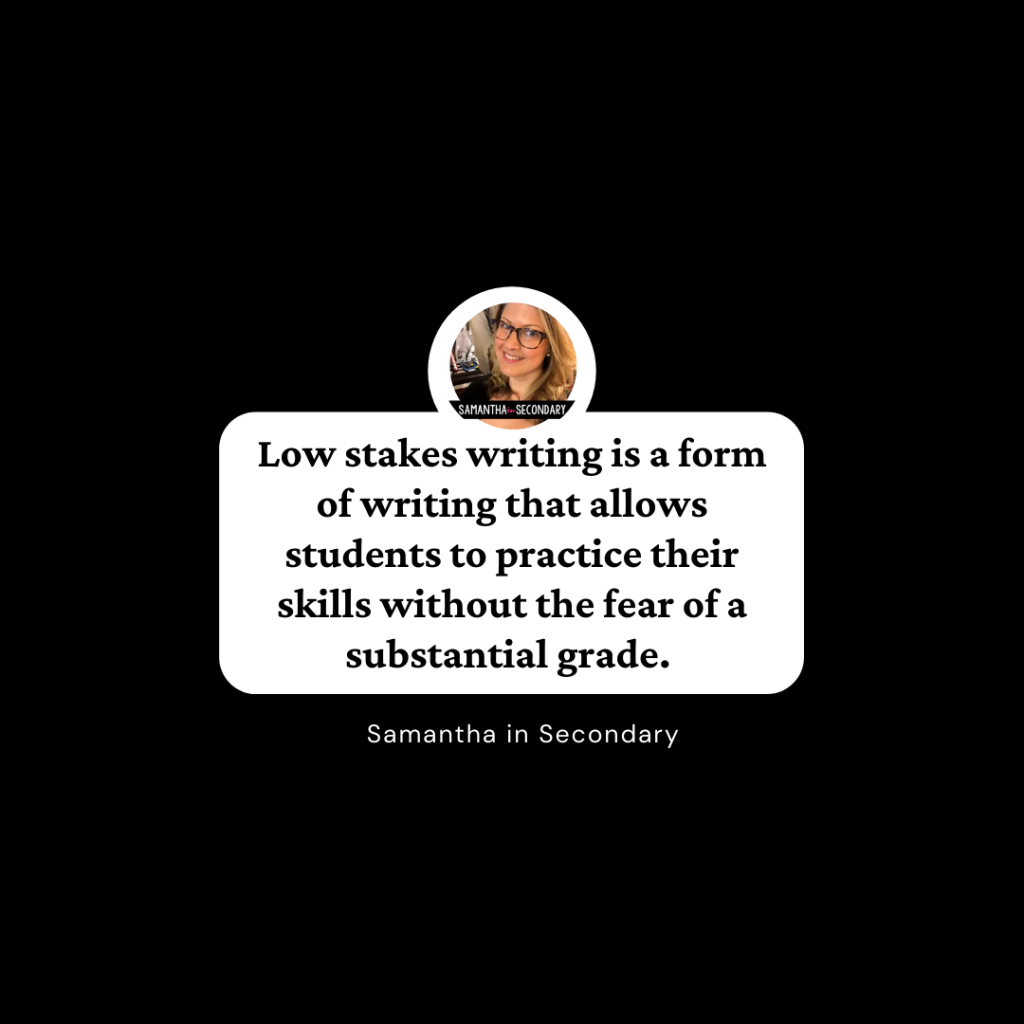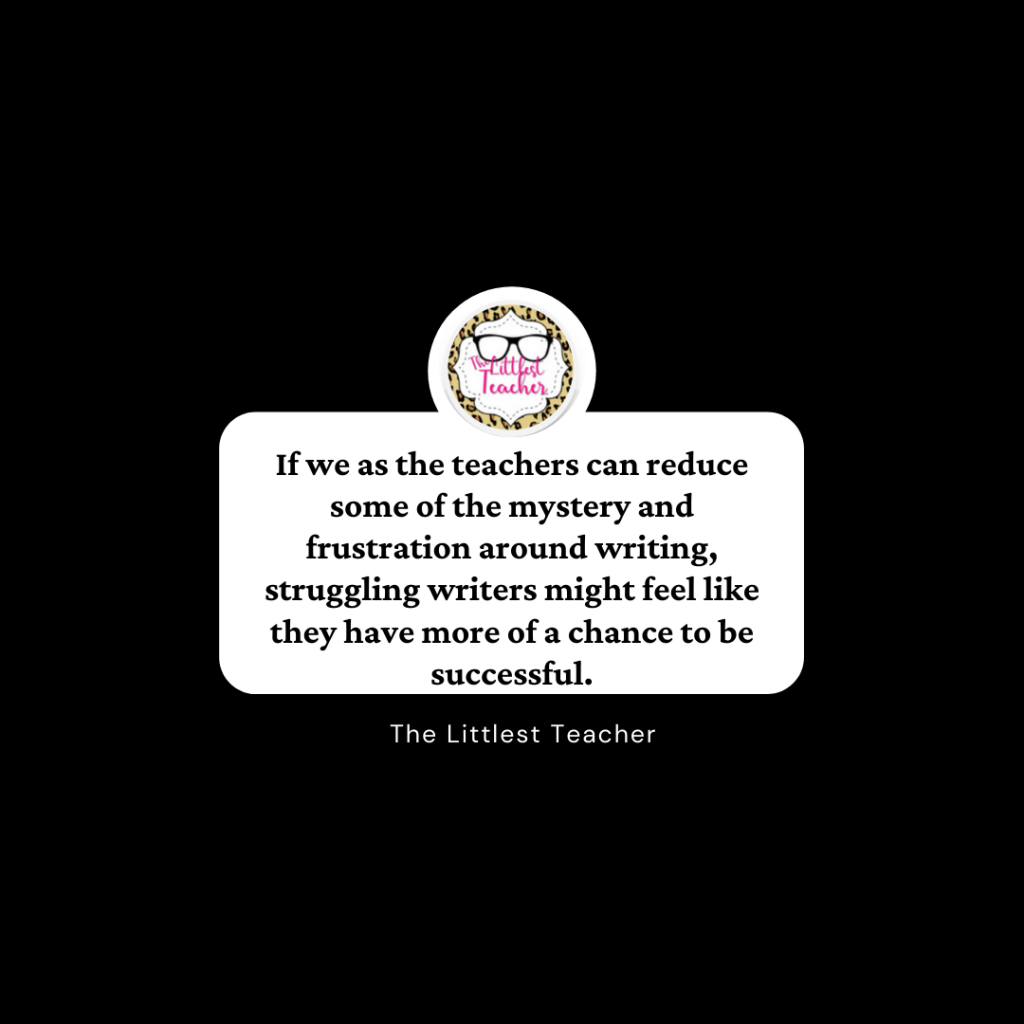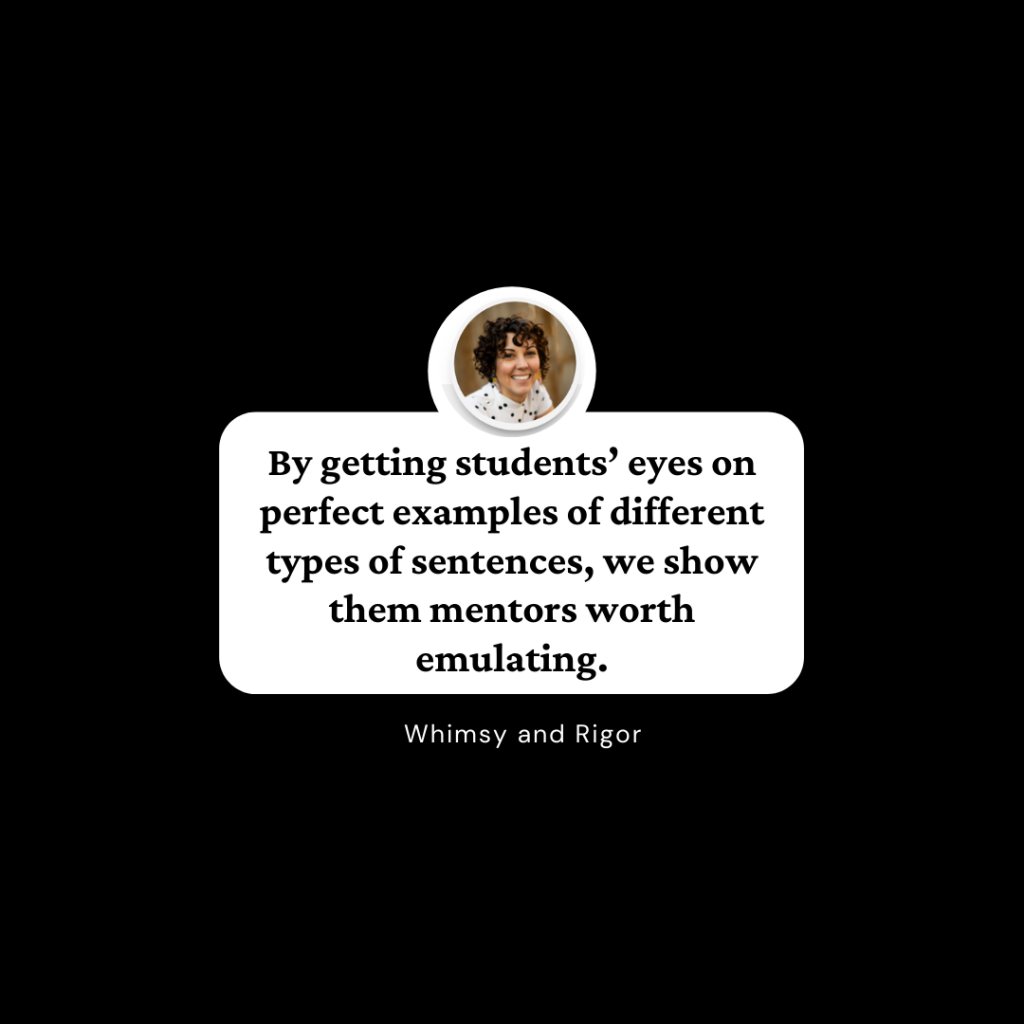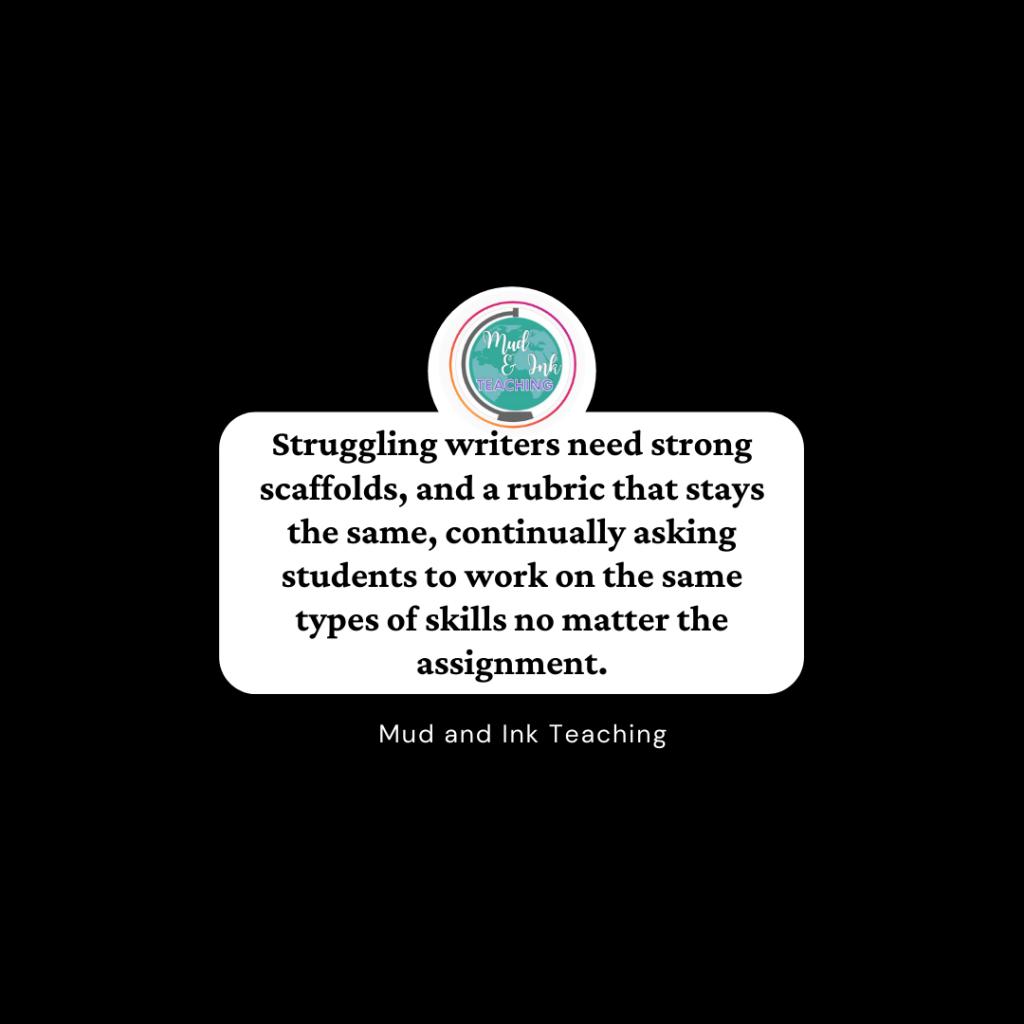
Writing is such a critical subject to master. Students who have confidence and skills as writers have the potential to go far in education and life. But, writing is one of the toughest subjects to teach and one of the subjects most students struggle with.
What’s worse is that many teachers have not even been trained to teach writing in their credential programs!
The teachers who collaborated on this blog post want to help. Here you will learn ways to teach writing in order to more fully support your struggling writers. Let’s get started…
1. Sentence Level Lessons
Many students struggle with writing, especially students with special needs and who are underserved. One reason, according to Judith C. Hochman and Natalie Wexler, is because they have not been taught explicitly how to craft a sentence, even at the elementary level. They are given assignments and activities rather than step by step instructions or direct instruction at the sentence level. As a teacher with eight years of experience in the elementary classroom, Amanda Write Now can attest to this phenomenon. Often teachers assume content has been taught at the previous grade level. The truth is this assumption is dangerous and can lead to many holes in students’ knowledge and skills as writers.
Many students would greatly benefit from starting at the sentence level. Hochman and Wexler, authors of The Writing Revolution describes a step-by-step process for how to do this. Even strong writers would benefit from sentence level instruction. Here are the steps:

- Teach about and have students practice using complete sentences by having students identify fragments, complete sentences, run on sentences and scrambled sentences.
- Teach about and have students practice using the four sentence types: statement, command, question and exclamation.
- Provide students with sentence stems that end in but, because and so. These stems can be related to the content you are currently teaching too so that you are not only teaching about how to expand sentences but also the content too.
- Teach about and have students practice using subordinating conjunctions such as although, since, before and after and have students use these words to craft sentences about the content you are teaching.
- Teach about and have students practice using appositives which are nouns that elaborate about other nouns in a sentence. This helps students expand upon an idea using commas. Do this at first using fill in the blank activities such as “Harriet Tubman,_____________, was born in 1821 on a plantation in Maryland.”
- Teach about and have students practice combining sentences. Do this by providing short related sentences that students have to put together into one sentence.
It’s important to note that Hochman and Wexler do not advise teaching complicated grammar terms when first introducing these concepts to students. Check out this blog post that includes 5 mini lessons to teach these concepts.
2. Low Stakes Writing

Low stakes writing is an excellent way to allow your students opportunities to practice what they’ve learned. Samantha from Samantha in Secondary likes to include multiple chances for low stakes writing in her daily lessons. Low stakes writing is an important part of any ELA classroom because it allows students to practice important learning, builds their confidence, and helps to prepare students for other types of writing.
So, what is low stakes writing and how do you use it in your ELA classroom? Low stakes writing is a form of writing that allows students to practice their skills without the fear of a substantial grade. When you assign low stakes writing, it should be graded lightly or not at all. A good time to implement low stakes writing is at the beginning of the class period in the form of a daily journal, quick write, bell ringer, or warm up. You can also implement this type of writing anywhere in a lesson as a reflection of the learning.
Visual Writing Prompts are a great way to pair low stakes writing with high engagement. They can be paired with any type of writing so students have an opportunity to practice the skills they’ve learned in class.
Having students keep a separate journal for all of their low stakes writing is always good practice. Provide periodic feedback to students by asking them to think more deeply about their writing or highlight sections where a student really shines. This allows students to improve in a relaxed, meaningful way.
Finding ways to implement low stakes writing in your classroom will provide students with a rich way to engage with text and improve their overall writing practice.
3. Multiple Tries
Struggling writers often feel discouraged because writing may not come as naturally to them as it does to their peers. They likely don’t enjoy writing and often feel confused or overwhelmed by the assignment, and intimidated at the prospect of being given a grade. Sometimes they have given up before they ever put pen to paper.
But if we as the teachers can reduce some of the mystery and frustration around writing, struggling writers might feel like they have more of a chance to be successful.
For shorter writing assignments, Molly at The Littlest Teacher likes to have students write several different compositions within the same genre.

For example, if you’re teaching summary writing, after the first lesson, have students summarize a brief paragraph. Model the writing and editing in real time so that students see the thought process behind the composition.
Over the next few class periods, have students summarize 2-3 more paragraphs on their own. Provide a specific checklist to guide their editing.
All of the summaries that students write can be counted for completion, but allow students to choose only one of their compositions to be turned in for a grade.
This simple-but-effective approach accomplishes several things: 1) the students get additional practice and exposure to the writing genre being taught; 2) struggling writers can feel more confident about turning in their writing for a grade, since they have the opportunity to choose what they feel is their best work for evaluation; 3) the stakes are lowered by having multiple chances to “get it right,” and students are less likely to feel paralyzed or overwhelmed by the pressure of having only one chance to learn how to and successfully create a certain type of composition.
4. Mentor Sentences

Gone are the days when teachers post sentences filled with errors and ask students to point out every mistake. And thank goodness for that! We want students to write well, right?! So why would we show them, over and over again, sentences that are not worth imitating?
Krista from @whimsyandrigor believes in the power of mentor sentences that show beautiful language, creative use of punctuation, and expert control of grammar…with ZERO errors.
In Jeff Anderson’s book, Mechanically Inclined, he details all the ways mentor sentences can empower young writers by helping them see the moves published authors make to create an idea.
For example, if you are teaching coordinating conjunctions (as Krista does in this YouTube video), display examples from literature and have students notice how the independent clauses come together to form a more detailed image in the reader’s mind. Play around with different conjunctions to explore how the meaning of the sentence changes. Allow students time to do a scavenger hunt for coordinating conjunctions in their independent reading books and share their findings with the class.
By getting students’ eyes on perfect examples of different types of sentences, we show them mentors worth emulating (thereby letting us teachers encounter sentences worth reading!).
5. Consistent Expectations & Criteria
Over the years of working with struggling writers, Amanda Cardenas of Mud and Ink Teaching has found that time and time again, working with consistent expectations and criteria is key.
Amanda has taught all different kinds of writing: creative writing, synthesis writing, argumentative writing, memoir, and narrative writing. What always seemed to compound any of the instructional struggles in the teaching of writing was the evaluation and feedback on what students actually were able to write. Struggling writers need strong scaffolds, and a rubric that stays the same, continually asking students to work on the same types of skills no matter the assignment, is one of the most powerful things teachers can do for their writers. Amanda has found that creating a rubric with student friendly language that is used over and over again helps writers see their progress across the year rather than a starting and ending point with every unit or genre of writing.

Coupled with consistent criteria is the immediacy of feedback. By using that same rubric over and over again, students learn to use the rubric itself as a feedback tool freeing up the teacher’s time for writing conferences and focused feedback for the students struggling the most. Amanda talks about this at length in the Brave New Teaching Podcast episode: To Tackle Two Big Grading Myths. Amanda knows that struggling writers are sometimes stuck before they even get started. If students are unclear as to what the teacher is expecting or how their work will be evaluated, sometimes, students can never really get going. Make writing expectations clear: this is a brain dump – no one’s going to see it! or this is a final draft, so let’s double check our writing rubric is an incredibly helpful place to start!
6. Writing Maker Spaces

For many writers, starting with loose parts can really help with the writing process. Betsy, from Spark Creativity, always turns to Angela Stockman, inventor of the writing makerspace, for ideas on how to help kids vault past writer’s block by “making” writing.
A writing makerspace doesn’t have to be expensive or overwhelming. Start with what you have – post-its, whiteboard markers, scrap paper, recyclables. Help kids build arguments, construct narratives, and create characters.
Tune into episode forty-seven of The Spark Creativity Teacher Podcast, “The Power of the Writing Makerspace,” to learn how to get started.
Further Reading
5 Mini Lessons to Teach Writing Explicitly and Support Struggling Writers
My Students Don’t Write During Writing
5 Simple Ways to Differentiate Writing Instruction

0 Comments